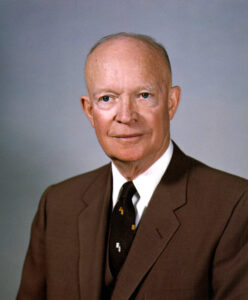“Our unity as a nation is sustained by free communication of thought and by easy transportation of people and goods.” – President Dwight D. Eisenhower, 1955
Between 1944 and 1956, America’s leaders launched one of the greatest building programs in human history, dramatically accelerating the nation’s pace of investment in roads, airports, electric power, telecommunications, water, hospitals, universities, and medical schools. These initiatives culminated in the pathbreaking National Interstate and Defense Highways Act of 1956, which built the world’s best ground transportation network. America’s post-World War II investments transformed the economic geography of the United States and helped cement the nation’s enduring economic edge over all other countries.
This essay is the last in a six-part George W. Bush Institute-SMU Economic Growth Initiative series on how America’s distinctive model for innovation and economic growth came to be. While federal policymakers had a long record of funding public works before World War II and undoubtedly would have continued to spend moderately on infrastructure absent any new policy initiatives, their decisions to boost funding to unprecedented levels after the war were a break from the past. Far from inevitable, they represented bold new bets on America’s future. In particular, the 1956 highway law, commonly known as the Interstate Highway Act, was the result of forceful advocacy by one visionary leader: President Dwight D. Eisenhower.
America’s vast postwar building boom contributed to the nation’s economic strength in two significant ways. First, it opened up significantly larger domestic markets for leading firms than they otherwise would have had. This helped many of the country’s strongest companies benefit from increasing returns to scale and enhanced their innovation and productivity advantages over competitors elsewhere in the world.
Second, it enabled economically less developed parts of the country – the South, above all – to close many of the enormous economic gaps that had separated them from America’s wealthiest regions since early in the country’s history. By powering the rise of the Sun Belt, the Interstate Highway Act and other federal investments tremendously expanded the geographic range of cutting-edge economic activities in the United States and the share of Americans engaged in them.
Infrastructure before 1941
Infrastructure investments played a pivotal role in America’s economic progress in the 19th century. The Erie Canal – which opened in 1825 and connected the Great Lakes with the Hudson River and ultimately New York Harbor – reduced regional shipping costs by more than three quarters and led to a 10-fold increase in grain shipments from the Midwest by 1852. It produced explosive growth in formerly remote rural areas in Illinois and Iowa by enabling farmers to get their produce to market efficiently and also to access modern equipment and consumer goods, as historian William Bernstein recounts in A Splendid Exchange: How Trade Shaped the World. America’s massive buildout of railroads likewise reduced the cost of shipping goods across land by almost 90% by late in the century and made dramatic population growth possible throughout the nation’s heartland as well as along the West Coast.
Another crucial infrastructure investment was in America’s land-grant colleges, built by state governments in the late 19th century on land granted by the federal government under the 1862 Morrill Act. Land-grant colleges, which numbered about 75 by 1900, helped diffuse valuable technologies for agriculture and other industries across the country.
The federal government continued to help states strengthen their infrastructure during the first four decades of the 20th century. In 1915, Congress established the federal Bureau of Public Roads, which distributed about $1.4 billion per year in the 1920s to support highway construction, measured in 2025 dollars. The federal government started building large-scale irrigation and hydropower infrastructure with the 1902 Reclamation Act and expanded its investment pace in the 1930s. It completed 16 dams along the Tennessee River between 1933 and 1944 and the giant Boulder Dam on the Colorado River – later renamed the Hoover Dam – in 1936. The same year, Congress passed the Rural Electrification Act, under which the Franklin D. Roosevelt Administration subsidized power investment across the country.
On the other hand, Congress provided little assistance to state and local initiatives on commercial aviation, telecommunications, universities, or hospitals between World War I and World War II. Roosevelt considered an ambitious highway initiative in 1938, but it made little headway before the war because Thomas MacDonald, longtime head of the Bureau of Public Roads, didn’t believe long-distance freight transportation would ever grow large enough to justify a new network of interstate highways.
Stark geographic disparities
Despite considerable investment in the 1930s, incomes and living standards on the eve of World War II varied across different regions of America to a degree that’s hard to imagine today. The industrial Northeast, Upper Midwest, and California stood out as the most advanced regions of the country. Farming regions in the Midwest and the Great Plains were less well off. But the South remained largely a world apart from the rest of the country in economic terms, physically isolated and far poorer than other regions.
Southern states – including those that had seceded in 1860 and 1861 as well as New Mexico and Arizona – had few quality roads and far fewer automobiles per capita than wealthy states, according to federal highway statistics. Less than 15% of Mississippi homes had electricity in the mid-1930s, compared with more than nine in 10 homes in Massachusetts. Fewer than one in five Southern homes had telephones in 1940, in contrast to Northern and West Coast states where more than half had them, according to data in Congressional Quarterly. Southern states on average had only two-thirds as much modern hospital capacity per capita as wealthier states. The South only had two universities with strong enough research capabilities to attract significant funding from the wartime Office of Scientific Research and Development: Duke University and the University of Texas at Austin.
While a substantial amount of low-wage textile manufacturing moved to the South during the interwar years, the South hosted very little manufacturing outside this industry. The region had only two of the nation’s 20 largest cities – No. 15 New Orleans, Louisiana and No. 20 Houston, Texas – reflecting the underdeveloped state of the region’s industrial and commercial sectors. Most Southerners still lived in rural poverty. Average incomes languished at less than half the Northeast’s level from the Reconstruction era after the Civil War to the 1920s and remained at just 52% in 1940, according to studies by economist Richard Easterlin.
The South’s relative backwardness reflected both physical and cultural isolation. Rudimentary transportation infrastructure made it all but impossible to manufacture most goods for national or foreign markets. Culturally, the South isolated itself further through Confederate nostalgia and resistance to modernization.
“The South has lived too long in the past,” Georgia Governor Ellis Arnall said in a 1945 speech. “It’s time she rejoined the Union. The narcotic that has been keeping the South in her twilight sleep is poverty. Her evasion of reality, her self-pity, her inertia has given her bad government.”
America starts building as never before, 1941-1952
All this started to change profoundly during and after World War II. America’s war mobilization became the most powerful force for economic change in the South since the Civil War. War production on the West Coast and elsewhere generated an unprecedented exodus of workers from the South, including an acceleration of the Great Migration of Black Americans out of the South. This made labor scarce for the first time since before the Civil War and led to large increases in real wages. War contracts also stimulated industrial production at facilities within the South like the Ingalls shipyard at Pascagoula, Mississippi.
The Armed Forces also built more than 20 significant bases in Southern states between 1940 and the end of the war. Wartime mobilization gave rise to rapid investment in roads and power. More than 30 Southern colleges, moreover, hosted military training programs, producing lasting physical as well as cultural changes in these institutions.
Starting in 1944, Congress made a series of decisions that led to an immense infrastructure building boom in the first three decades after World War II. In 1944, Congress passed the Federal-Aid Highway Act, which laid out plans for a 40,000-mile network of major highways and stepped up funding to about $4 billion to $5 billion per year, well above what the federal government had spent in the New Deal years.
In 1946, Congress passed the Federal Airport Act, which helped fund a vast buildout of airports across the country. Commercial flights would increase almost 50-fold from 1950 to 1980, according to data in Robert Gordon’s book The Rise and Fall of American Growth. Congress also passed the Hill-Burton Act in 1946, supporting construction of thousands of modern hospitals in underserved areas.
During the late 1940s, moreover, the federal government significantly boosted investment in electric power and dams. The share of rural homes with electricity rose from just over one-third at the end of the war to 96% by 1956. Congress stepped up telecommunications investment as well, leading to near-total residential access by the 1960s. Congress’s budget for water infrastructure rose more than sixfold by the mid-1950s from its late 1930s level, according to data from the Congressional Record and Donald Worster’s book Rivers of Empire: Water, Aridity, and the Growth of the American West. Most of the large dams that enabled the growth of Southern and Southwestern cities were built between 1950 and 1980.
Congress additionally started providing generous support for medical education, which together with the new federal research grant system roughly doubled the number of medical schools and enabled the average medical school to raise its budget 12-fold by 1969 from its 1940 level, according to historian Paul Starr in The Social Transformation of American Medicine. This paid for construction of modern facilities at academic medical centers across the country, tremendous growth in lifesaving medical research, and a tripling in the number of new physicians graduating each year from 1949 to 1980.
Eisenhower’s vision
By the 1950s, it was clear that the pace of road construction under Congress’s 1944 highway act was insufficient. America’s booming economy had generated explosive increases in freight transportation on the country’s highways and railroads. Oversimplistic studies during the war, moreover, had underestimated the cost of building a world-class highway system.
A more thorough study commissioned by President Eisenhower shortly after he took office concluded that it would cost $325 billion (in 2025 dollars) over 12 years to build a network sufficient for the nation’s projected needs by 1980. The study also called for building entirely new highways along the most efficient possible routes, rather than upgrading existing prewar roads as the 1944 act mostly envisioned. This would mean more than tripling the annual pace of highway work.
But expanding the federal government’s role in road construction faced opposition from railroad interests that didn’t want competition, congressional conservatives who wanted to restrain spending and keep federal authorities out of what they viewed as state business, and even trucking firms opposed to any additional gasoline taxes to help pay for construction. From the late 1940s to 1952, neither President Harry Truman nor any senior member of Congress stepped up on the issue. Highway infrastructure became a top national priority in 1953 thanks to forceful, determined leadership by President Eisenhower.
President Eisenhower remembered his hometown of Abilene, Kansas, as a remote, isolated place where the dirt roads would often turn into a muddy soup that made it impossible to get in or out of town by automobile. As a young Army officer, he had participated in a 1919 military convoy that traveled from Washington to San Francisco to assess the country’s roads. The convoy took 62 days to cross the country, often moving at less than 5 miles per hour. It had to abandon a 10th of its vehicles along the way because of irreversible breakdowns caused by dreadful road conditions, as Stephen Ambrose recounts in his two-volume biography of the president.
When then-General Eisenhower first entered Germany as Supreme Allied Commander in April 1945, he saw Germany’s ultramodern autobahn highways for the first time. He was amazed by the stark contrast with America’s roads. Seeing the autobahns confirmed for Eisenhower that America needed to build a world-class highway system spanning the country as a top national priority.
His determination to modernize America’s infrastructure was an important part of the optimistic, expansive outlook he brought to the presidency. Before becoming president, he played key roles in two decisions we highlight in this series: the GI Bill and the Marshall Plan. As president, he also expanded science research and sustained the multilateral trade liberalization effort launched in 1947 by Under Secretary of State Will Clayton. On interstate highways, his leadership made all the difference.
In his first three months in office, President Eisenhower replaced the head of the Bureau of Public Roads and launched new studies to lay the foundation for an unprecedented highway initiative. When the planning effort proved too slow, President Eisenhower appointed former General Lucius Clay, a close wartime colleague, to take charge. Clay quickly delivered a thorough plan, and President Eisenhower asked Congress to approve it.
But President Eisenhower underestimated the opposition his signature proposal would attract. Opponents killed his bill in 1955. Two months after this defeat, President Eisenhower suffered a massive heart attack, leading many to write off his highway program for the foreseeable future. Over the next year, however, the president turned the tide. Working tirelessly to build public support and pressure Congress, he persuaded lawmakers to come back to the table and reach a compromise, as recounted in Ambrose’s biography and Dan Nichols’ book The Roads that Built America: The Incredible Story of the U.S. Interstate Highway System. Congress approved the Interstate Highway Act in June 1956.
The Interstate Highway Act transforms the economic geography of the nation, 1953-1991
The United States ultimately spent about $700 billion building interstate highways between 1957 and 1991, measured in 2025 dollars. The federal government covered 90% of the cost, and state government covered the rest. The network was an engineering marvel. The system included 104 tunnels, including a route under Baltimore’s harbor that was one of the longest underwater tunnels in the world. It also featured more than 55,000 bridges, such as the world’s longest cable-stayed concrete bridge connecting St. Petersburg and Bradenton in Florida.
The interstate highways had monumental effects on America’s economy. Freight movement, measured in ton-miles, sextupled from 1956 to 2023, a period in which the nation’s population merely doubled, according to U.S. Department of Transportation statistics. Roads came to account for a considerably larger share of freight transportation than railroads, even though rail grew significantly as well.
Because road transport is more flexible than rail, much of the continental United States for the first time became sufficiently close to modern transportation routes to make new kinds of economic activity possible. Cities that had previously been too remote to support significant oceangoing or cross-border commerce like Savannah, Georgia, and El Paso, Texas, emerged as major ports for import-export trade. Many cities at interstate junctions, now well-supplied with water as well thanks to federal water works, experienced staggering growth. Leading examples included Atlanta, Georgia; Charlotte, North Carolina; Nashville, Tennessee; Dallas and Houston, Texas; Phoenix, Arizona; and Las Vegas, Nevada. Manufacturing facilities arose in locations that would never have made economic sense before, such as automobile plants in Alabama, South Carolina, and Tennessee.
The interstates also connected farmers in the Midwest and Great Plains to global markets far more effectively than rail ever could have done, helping America’s heartland become one of the most productive agricultural regions on Earth. Food exports grew tremendously.
The interstate highway system had transformative effects within metropolitan areas as well. By expanding people’s ability to commute by car, it powered the rise of suburban communities across the country. Together with federal loan guarantees under the GI Bill and the Federal Housing Administration, this vast expansion into previously remote areas led to a historic homebuilding boom that kept housing relatively affordable for the rest of the 20th century.
On the other hand, suburban growth undermined the economic vitality of many core cities. President Eisenhower himself came to regret that his program funded not just long-distance connections between cities and states but also routes through the middle of built-up urban areas, in many cases sweeping away low-income, majority-Black neighborhoods. A few cities – including New York, New York; Washington, D.C.; and New Orleans, Louisiana – managed to block routes through their urban cores, as Tom Lewis recounts in Divided Highways: Building the Interstate Highways, Transforming American Life.
The Sun Belt rises
America’s postwar building boom fully closed the once-immense infrastructure gaps between the nation’s poorest and richest areas. Electricity use per capita in Southern states fully caught up with Northeastern and West Coast levels by 1960 and pulled modestly ahead in the 21st century. Access to safe water and modern plumbing fully caught up by 1980 as well.
The South’s share of leading research universities became roughly commensurate with its share of the nation’s population, as economist Miguel Urquiola shows in Markets, Minds, and Money: Why America Leads the World in University Research. By 2024, Southern states were home to 12 of the top 50 cancer centers, based on U.S. News & World Report rankings.
They also now accounted for 15 of America’s 50 largest metro areas. The South, which had experienced net population outflows to other regions since well before the Civil War, became a magnet for domestic migration. Southern states, including the Southwest, now have 39% of the nation’s population, compared with an all-time low of 28% in 1960.
Incomes mostly caught up as well. Median household incomes rose to about 90% of levels prevailing in the Northeast by 2023, up from just over half of Northeastern levels on the eve of World War II, based on my analysis of U.S. Census and Bureau of Economic Analysis data. Economic opportunity – plus air conditioning – made the Sun Belt what it is today.
Geography and American economic growth
By making it possible to manufacture in more locations and move people and goods around more easily, the interstates generated large increases in productivity across America’s economy, studies have shown.
On the whole, America outperformed most wealthy peer nations for infrastructure investment during the first three decades after World War II, though with many nuances. Some countries – notably Germany and France – built out excellent highway networks at the same time as the United States, while others like the U.K. and Japan were slower to do so. Japan led the world in building high-speed rail connections, opening its Shinkansen service for the 1964 Tokyo Olympics. France followed with its TGV rail system, but other European nations didn’t create high-speed rail links until later. On the other hand, peer countries mostly invested less than America did in road connections off the main routes connecting large metros.
Leading peer countries generally focused on expanding just one or at most two major airports, focusing on international connections, in the early postwar decades. Most peer nations invested much less than the United States in building out universities and medical schools in underinvested areas in the late 20th century, though socialized medical systems generally did a good job expanding their hospital networks.
Summing up the comparisons, America closed the gaps holding back its least developed regions more successfully than any peer country. This success became visible in economic outcomes. The average trucking trip in the United States covered two and a half times as much distance as the average trip in continental Europe in the early 21st century. It would only be 1.4 times as long if the two economies had equivalent road networks and equally integrated markets, I estimate based on Europe’s smaller size. Thirty percent of truck trips crossed state lines by 1955 – more than the share that cross national lines in the European Union today. This gap is not due to better rail transportation in Europe, as the average trip for freight traveling by rail is almost six times longer in the United States than in the European Union.
By the early 21st century, disparities in educational attainment between wealthy and lower-income U.S. states were considerably smaller than equivalent geographic gaps separating richer and poorer regions within Germany, France, Italy, Spain, or the Netherlands.
Average incomes in the lowest-income regions of France and the U.K. today are between 70% and 80% of those in high-income areas in the same countries – a much wider gap than the 10% difference between the American South and the Northeast. In Japan, average incomes in left-behind prefectures are less than half the level enjoyed by the richest ones. In Germany, the states of the former East Germany remain far behind western states, but even within the old West Germany, geographic disparities are wider than those in the United States. American firms therefore enjoy much larger, geographically integrated domestic markets for their goods and greater flexibility on where to manufacture than their competitors in peer countries, strengthening their competitive advantages.
America’s success at decentralizing its most innovative activities also represents an underappreciated source of the nation’s economic advantages. Concentrating leading-edge activities in a single dominant location like London or Paris runs into the problem that the dominant metro area typically can’t add enough housing, which consequently becomes extraordinarily expensive. Housing prices choke off demographic growth, which in turn results in less innovative work taking place. By contrast, the rise of R&D-intensive activities in places like North Carolina’s Research Triangle and the four metros of the Texas Triangle – Austin, Dallas-Fort Worth, Houston, and San Antonio – have enabled America to do more innovative work overall on a per capita basis.
Does 21st century America have an infrastructure crisis?
America’s infrastructure edge has weakened in recent decades. One reason, I calculate based on GDP data, is that federal infrastructure spending has fallen to historically low levels as a share of the U.S. economy. This has remained the case even after the 2022 Infrastructure Investment and Jobs Act in part because that legislation allocated a relatively small share of funding to traditional infrastructure like roads, bridges, and ports and a relatively large amount to renewable energy projects.
America also gets less bang for the buck on its infrastructure spending. Increasingly byzantine regulations in many states make it comparatively expensive to add or upgrade infrastructure in the United States today. Adding a mile of highway costs as much as three times more in the United States than in European countries, a Brookings report shows.
Power investment is failing to keep up with demand, which is growing faster than it has in decades because of AI-focused data center construction. Western water systems are deteriorating as vital facilities like the Hoover and Glen Canyon dams silt up and overuse draws down the water stored in them.
On the other hand, America’s system of divided responsibilities across the federal government, state governments, and the private sector has proved resilient in many respects. Fast-growing Sun Belt metros have mostly built out road and water infrastructure fast enough to keep up with rapid growth in the 2010s and 2020s. Companies like Amazon have built out the world’s best infrastructure for distributing goods directly to people’s homes. While data center investment is straining the nation’s power grid, the United States is still outperforming all other countries in AI-focused investments.
But building the infrastructure to support future prosperity is a never-ending task. America needs to make it easier to build roads, bridges, rail links, power facilities, water distribution lines, air terminals, and hospitals as well as houses and apartments. As the Interstate Highway Act showed, taking the long view and building for the distant future pays off.





























